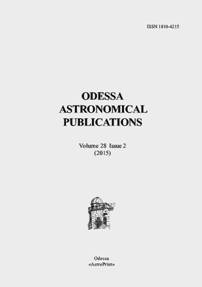THE REACTION OF PHOSPHORUS-CONTAINING INTRACELLULAR INCLUSIONS TO SPACE WEATHER CHANGES
DOI:
https://doi.org/10.18524/1810-4215.2015.28.71074Ключові слова:
space weather, polyphosphate, volutin granules, bio-astronomical effect, metachromatic reactionАнотація
It is known that the bio-astronomical effect of Chizhevsky-Velhover is based on the cytochemical metachromatic reaction of polyphosphatecontaining volutin granules of microorganisms. As a result of long-term monitoring (2001-2015 years) of this of cytochemical index in yeasts Saccharomyces cerevisiae, it was shown that metachromatic staining of the granules possessed rhythmicity and connection with space weather. Under laboratory conditions the change of metachromasy was achieved by applying different stress factors: anaerobiosis, low temperature, acidity. Simulation of metachromatic staining in vitro by using solutions of inorganic polyphosphate with other compounds showed that this reaction was possible for the low concentrations of these polymers. The effect of the low concentrations was more expressed with increasing chain length of polyphosphate. The inhibition of the metachromasy in solution with added protein and calcium chloride indicated that this of reaction involved the presence of the protonated sites in the polymers. It is assumed that metachromatic staining of volutin granules in vivo may depend on other conditions including conformational restructuring of a polymer or sol-gel phase transitions. Thus, the question whether the metachromatic reaction of intracellular polyphosphate granules to the space weather changes is driven by a response to associated stress or despite the apparent similarity of the effects they are of a different nature remains unclear.Посилання
A quick reference guide to space biology and medicine. Moscow: Medicine, 1967 (in russian).
Serafim L.S., Lemos P.C., Levantesi C., Tandoi V., Santos H., Reis M.A.M.: 2002, Journal of Microbiological Methods, 51, 1-18.
Brown M.R.W., Kornberg A.: 2004, PNAS, 101, №46, 16085.
Lichko L., Kulakovskaya T., Pestov N., Kulaev I.: 2006, Biosci. Rep., 26, 45.
Practicum for microbiology: tutorial guide /ed. Egorov N.S., Moscow: Moscow University Press, 1976, 307 p. (in russian).
Gromozova E.N., Grigoriev P.E., Kachur T.L., Voychuk S.I.: 2010, Biophysical processes and Biosphere, 9, No 2, 67 (in russian).
Vladimirsky B.M. Impact of solar activity on biospherenoosphere (Heliobiology from Chizhevsky A.L. to the present days) /B.M.Vladimirsky, N.A.Temurjyants, М: Publishing house, 2000, 374 p. (in russian).
Shirai M., Nagatsuka T., Tanaka M.: 1977, Micromol. Chem., 178, 37.
Lorenz B., Schröder H.C.: 1999, Inorganic Polyphosphates. Biochemistry, Biology, Biotechnology, Springer, 217 (in russian).
Ault-Riche D., Fraley C.D., Tzeng C.-M., Kornberg A.: 1998, Journal of Bacteriology, 180, No7, 1841.
Pierce E. Histochemistry theoretical and applied /ed. E. Pearce, Moscow: Univ. foreign. literature, 1962, 962 p. (in russian).
##submission.downloads##
Опубліковано
Як цитувати
Номер
Розділ
Ліцензія
Авторське право (c) 2015 Odessa Astronomical Publications

Ця робота ліцензується відповідно до Creative Commons Attribution-NonCommercial 4.0 International License.
Відповідно Закону України про авторське право і суміжні права N 3792-XII від 23 грудня 1993 року
